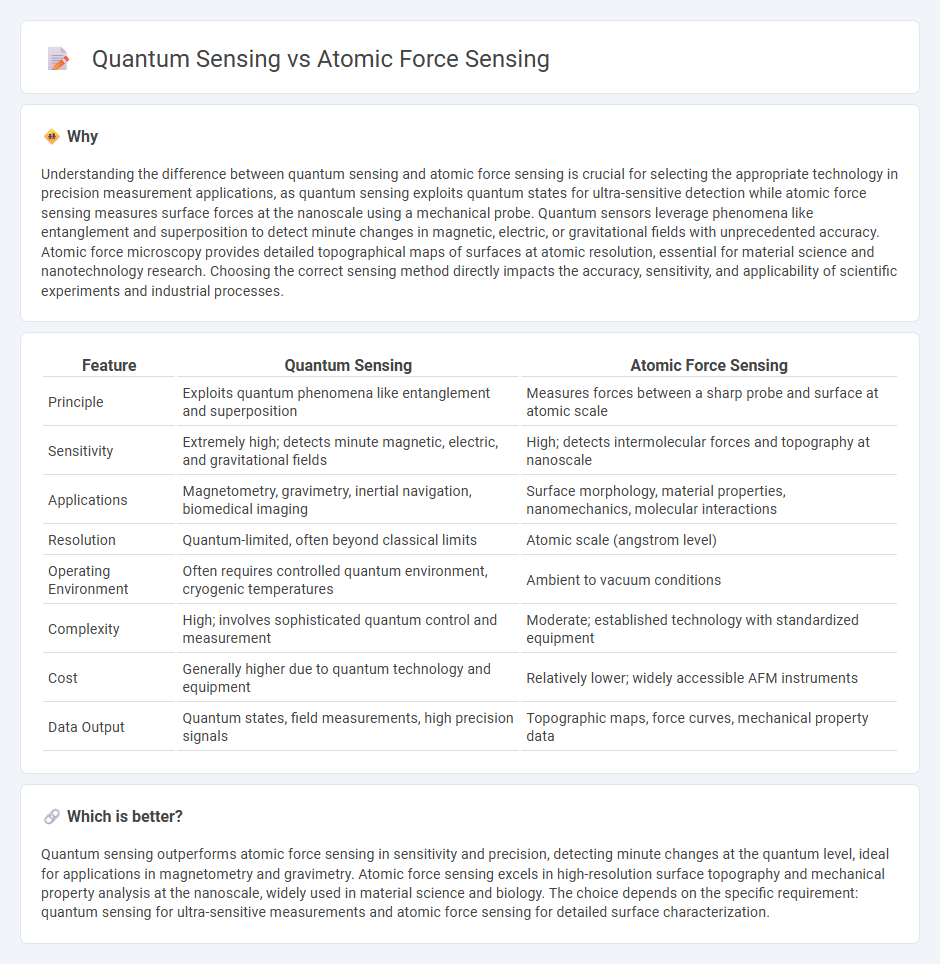
Quantum sensing harnesses quantum phenomena such as entanglement and superposition to achieve ultra-sensitive measurements beyond classical limits. Atomic force sensing employs a mechanical probe that interacts with surfaces at the nanoscale, enabling high-resolution imaging and force detection. Explore how these cutting-edge technologies redefine precision measurement and their unique applications.
Why it is important
Understanding the difference between quantum sensing and atomic force sensing is crucial for selecting the appropriate technology in precision measurement applications, as quantum sensing exploits quantum states for ultra-sensitive detection while atomic force sensing measures surface forces at the nanoscale using a mechanical probe. Quantum sensors leverage phenomena like entanglement and superposition to detect minute changes in magnetic, electric, or gravitational fields with unprecedented accuracy. Atomic force microscopy provides detailed topographical maps of surfaces at atomic resolution, essential for material science and nanotechnology research. Choosing the correct sensing method directly impacts the accuracy, sensitivity, and applicability of scientific experiments and industrial processes.
Comparison Table
| Feature | Quantum Sensing | Atomic Force Sensing |
|---|---|---|
| Principle | Exploits quantum phenomena like entanglement and superposition | Measures forces between a sharp probe and surface at atomic scale |
| Sensitivity | Extremely high; detects minute magnetic, electric, and gravitational fields | High; detects intermolecular forces and topography at nanoscale |
| Applications | Magnetometry, gravimetry, inertial navigation, biomedical imaging | Surface morphology, material properties, nanomechanics, molecular interactions |
| Resolution | Quantum-limited, often beyond classical limits | Atomic scale (angstrom level) |
| Operating Environment | Often requires controlled quantum environment, cryogenic temperatures | Ambient to vacuum conditions |
| Complexity | High; involves sophisticated quantum control and measurement | Moderate; established technology with standardized equipment |
| Cost | Generally higher due to quantum technology and equipment | Relatively lower; widely accessible AFM instruments |
| Data Output | Quantum states, field measurements, high precision signals | Topographic maps, force curves, mechanical property data |
Which is better?
Quantum sensing outperforms atomic force sensing in sensitivity and precision, detecting minute changes at the quantum level, ideal for applications in magnetometry and gravimetry. Atomic force sensing excels in high-resolution surface topography and mechanical property analysis at the nanoscale, widely used in material science and biology. The choice depends on the specific requirement: quantum sensing for ultra-sensitive measurements and atomic force sensing for detailed surface characterization.
Connection
Quantum sensing and atomic force sensing both exploit quantum mechanical properties to achieve ultra-sensitive measurements at the nanoscale. Quantum sensing utilizes phenomena like superposition and entanglement to detect minute changes in magnetic, electric, or gravitational fields, while atomic force sensing measures forces between a sharp probe and a sample surface with atomic precision. The integration of quantum techniques in atomic force microscopy enhances its sensitivity and resolution, enabling breakthroughs in materials science and biological research.
Key Terms
Cantilever (Atomic Force Sensing)
Cantilever-based atomic force sensing uses microfabricated beams to detect minute forces with high spatial resolution by measuring cantilever deflections, enabling nanoscale surface characterization and material property analysis. Quantum sensing techniques, in contrast, leverage quantum phenomena such as superposition and entanglement to achieve enhanced sensitivity and precision beyond classical limits, particularly in measuring magnetic and electric fields or temperature. Explore our detailed comparison to understand the advancements and applications of cantilever atomic force sensors versus quantum sensing technologies.
Quantum Superposition (Quantum Sensing)
Quantum sensing leverages quantum superposition to achieve unparalleled sensitivity by exploiting the ability of quantum states to exist simultaneously in multiple configurations, allowing detection of minute changes in physical quantities like magnetic and electric fields. Atomic force sensing, by contrast, relies on the mechanical deflection of a cantilever to measure forces at the nanoscale but lacks the fundamental quantum advantages of superposition. Explore the potential of quantum superposition in quantum sensing to understand its transformative impact on precision measurement technologies.
Sensitivity Limit
Atomic force sensing achieves sensitivity limits governed by thermal noise and cantilever properties, typically detecting forces in the pico- to femtonewton range. Quantum sensing exploits quantum coherence and entanglement, surpassing classical limits and enabling detection of forces at the zeptonewton or even sub-zeptonewton scale. Explore advanced methodologies and comparative studies to deepen understanding of sensitivity limits in these sensing techniques.
Source and External Links
Atomic force microscopy - AFM works by scanning a cantilever with a sharp tip over a sample surface where atomic forces alter the cantilever's vibration frequency, allowing identification of individual atoms based on these force interactions.
Review: Cantilever-Based Sensors for High Speed Atomic Force Microscopy - Advances in microcantilever-based sensors enable highly sensitive atomic force measurements utilized in AFM, especially in biological and chemical sensing applications.
Atomic Force Microscopy - An Overview from Asylum Research - AFM uses a cantilever with a nanoscale tip whose deflection caused by surface forces is detected optically to produce high-resolution topographical maps of diverse sample surfaces.
 dowidth.com
dowidth.com